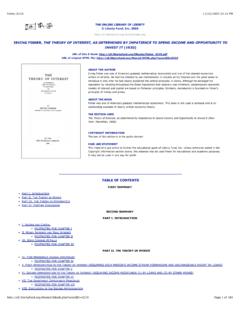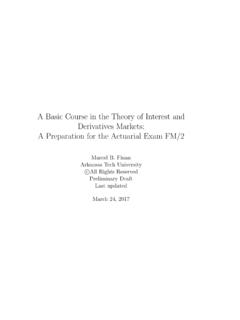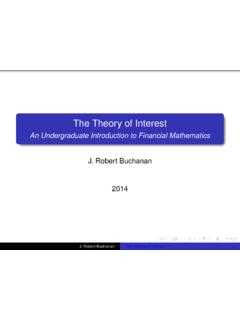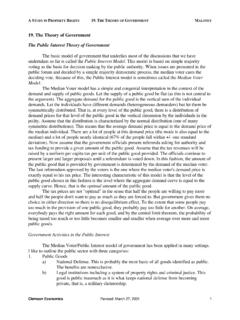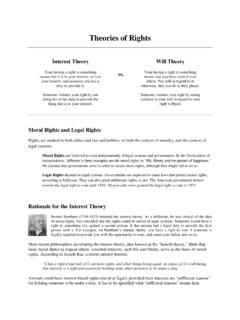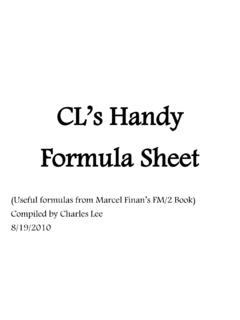Transcription of Chapter 1. Theory of Interest 1. The measurement of ...
1 Chapter of Interest1. The measurement of IntroductionInterestmay be defined as the compensation that a borrower of capitalpays to lender of capital for its use. Thus, Interest can be viewed as a form ofrent that the borrower pays to the lender to compensate for the loss of use ofcapital by the lender while it is loaded to the borrower. In Theory , capital andinterest need not be expressed in terms of the same ratesof Interest and discount; value; Interest and discount; The accumulation and amount functionsPrincipal:The initial of money (capita) invested;Accumulate value:The total amount received after a periodof time.
2 Amount of Interest :The difference between the accumulatedvalue and the period:The unit in which time is functiona(t):The function gives the accumulatedvalue at timet 0of an original investment of (0) = (t)is generally an increasing function if the Interest is (t)will be continuous if Interest accrues functionA(t):The accumulated value at timet ofan original investment (t) =k a(t)andA(0) =kAmount of InterestInearned during thenth period from thedate of invest:In=A(n) A(n 1), n (t)(a)0(b)tA(t)0(c)tA(t)0(d)tA(t)Figure 1: Four illustrative amount The effective rate of interestPrecise definition:The effective rate of interestiis the amountof money that one unit invested at the beginning of a period willearning during the period, where Interest is paid at the end of definition is equivalent toi=a(1) a(0)ora(1) = 1 + definition:i=(1 +i) 11=a(1) a(0)a(0)=A(1) A(0)A(0)=I1A(0).
3 7 Letinbe the effective rate of Interest during thenth periodfrom the date of investment. Then we havein=A(n) A(n 1)A(n 1)=InA(n 1), n 1. The use of the word effective is not intuitively clear. The effective rate of Interest is often expressed as apercentage, 8%. The amount of principal remainsconstantthroughout theperiod. The effective rate of Interest is a measure in which Interest ispaid atend of Simple Interest and Compound InterestSimple Interest :The accruing of Interest according to thefollowing patter is called simple (t) = 1 +itfor integralt the rate of simple Interest and letinbe the effective rateof Interest for thenth period.
4 Then we havein=a(n) a(n 1)a(n 1)=[1 +in] [1 +i(n 1)]1 +i(n 1)=i1 +i(n 1)for integraln morerigorous mathematical approachfor simple interestto the definition ofa(t)for nonintegral value of t:a(t+s) =a(t) +a(s) 1fort 0ands (t)is differentiable, we havea (t) = lims 0a(t+s) a(t)s= lims 0[a(t) +a(s) 1] a(t)s= lims 0a(s) 1s= lims 0a(s) a(0)s=a (0)10 Soa (t)is a constant, we havea(t) a(0) = t0a (r)dr= t0a (0)dr=t a (0)a(t) = 1 +t a (0)Remember thata(1) = 1 +i= 1 +a (0),soa(t) = 1 +it, t Interest :The word Compound refers to the processof Interest being reinvested to earn additional Interest .
5 The theoryof compound Interest handles the problem by assuming that interestearned is automatically function for a constant compound Interest :a(t) = (1 +i)tfor integralt interestin=a(n) a(n 1)a(n 1)=(1 +i)n (1 +i)n 1(1 +i)n 1=1 +i 11= is independent mathematical approachfor compound Interest to thedefinition ofa(t)for nonintegral value of t:a(t+s) =a(t) a(s)fort 0ands 0 Assuminga(t)is differentiable, we havea (t) = lims 0a(t+s) a(t)s= lims 0a(t) a(s) a(t)s=a(t) lims 0a(s) 1s=a(t) a (0).13 Thusa (t)a(t)=ddtlogea(t) =a (0).andlogea(t) logea(0) = t0ddrlogea(r)dr= t0a (0)dr=t a (0)Sincelogea(0) = 0, if we lett= 1and remember thata(1) = 1+i,we havelogea(1) = loge(1 +i) =a (0)andlogea(t) =tloge(1 +i) = loge(1 +i)tora(t) = (1 +i)tfort between simple and compound Interest : Same results over one measurement period.
6 Over a longerperiod, compound Interest produces a larger accumulated valuethan simple Interest while the opposite is true over a shorterperiod. Under simple Interest , it is theabsolute amountof growth thatis constant over equal periods of time, while under compoundinterest, it is the relative rate of growth that is constant. Compound Interest is used almost exclusively for financialtransaction covering a period of one year or more and isoften used for shorter term transaction as well. Simpleinterest is occasionally used for short-term transaction and as anapproximation for compound Interest over fractional 1:Find the accumulated value of $2000 invest forfour years, if the rate of simple Interest and compound rate is 8%annum answer isFor simple Interest :2000[1 + (.)]
7 08)(4)] = compound Interest :2000( )4= Present Value Accumulation factor:1 +i. It accumulates the value of aninvestment at the beginning of a period to its value at end ofthe period. Discount factor:v=11+i, it discounts the value of aninvestment at end of a period to its value at the beginningof the period. Discount function:a 1(t), sincea 1(t) a(t) = Interest :a 1(t) =11 +itCompound Interest :a 1(t) =1(1 +i)t=vt17 Accumulating and discounting are opposite processes. The term(1 +i)tis said to be theaccumulated valueof 1 at the end oftperiod. The termvtis said topresent valueof 1 to be paid atthe end 2:Find the amount which must be invested at arate of simple Interest of 9% per annum in order to accumulate $1000 at end of three answer is10001+(.
8 09)(3)= $ 3:Rework the example above using compound interestinstead of simple answer is1000v3=1000( )3= $ The effective rate of discountNumerical illustration:If A goes to a bank and borrow $100 for one year at an effectiverate of Interest of 6%, then the bank will give A $100. At the endof the year, A will repay the bank the original loan of $100, plusinterest $6 or a total of $ , if A borrows $ 100 for one year at an effective rateof discount of 6%. then the bank will collect its Interest of 6% inadvance and will give A only $94. At end of the year, A will repay$ the case of an effective rate of Interest , the 6% is taken asa percentage of the balance at the beginning of the year, whilein the case of an effective rate of discount , the 6% is taken aspercentage of the balance at the end of the of the effective rate of discount:The effectiverate of discountdis the ratio of the amount of Interest (sometimescalled the amount of discount or just discount ) earned duringthe period to the amount invested at end of the period.
9 The phrases amount of discount and amount of Interest can beused interchangeably in situations involving rates of discount. The definition does not use the word principal , since thedefinition of principal refers to the amount invest at thebeginning of the period and not at the end of the key distinction between the effective rate of Interest andthe effective rate of discount can be summarized as follows:a) Interest -paid at end of the period on the balance at the beginningof the )Discount-paid at the beginning of the period on the balance atthe end of the ratesdnof discount over anyparticular measurementperiod:dn=A(n) A(n 1)A(n)=InAnfor integraln discount.
10 If we have compound Interest , in whichcase the effective rate of Interest is constant, then the effectiverate of discount is also constant. This situations are referred to ascompound between effective rates of Interest and effectiverates of discountConcept of equivalency:Two rates of Interest or discount aresaid to be equivalent if a given amount of principal invested forthe same length of time at each of the rates produces the sameaccumulated that a person borrows 1 at an effective rate of the effective rate of Interest isi=d1 d22By simple algebra, we also getd=i1 +i,d=iv, d= 1 v,andi d=id Simple discount:a 1(t) = 1 dt.

